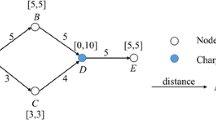Abstract
Electric vehicle (EV) sharing has experienced rapid development and has served as a flexible and environmental friendly means for urban transportation. However, charging an EV sharing fleet is still a challenge for business operators because of limited or costly access to charging facilities. In this chapter, we focus on how to charge a fleet to make EV sharing viable and profitable. Adopting the real data of car2go, we propose a queueing network model to characterize how customers endogenously pick EVs according to energy levels, as well as the implementation of a charging-up-to policy. In order to solve the proposed nonlinear optimization program, we develop mixed-integer second order cone programs as tractable lower- and upper-bound formulations. These models lead to practical insights related to charger resource availability and locations, EV charging policy, battery technological advancements, and urban spatial structure.
Access this chapter
Tax calculation will be finalised at checkout
Purchases are for personal use only
Similar content being viewed by others
References
Abouee Mehrizi H, Baron O, Berman O, Chen D (2018) Adoption of electric vehicles in car sharing market. Working paper
Blomgren GE (2017) The development and future of lithium ion batteries. Journal of The Electrochemical Society 164(1):A5019–A5025
Boyacı B, Zografos KG, Geroliminis N (2015) An optimization framework for the development of efficient one-way car-sharing systems. European Journal of Operational Research 240(3):718–733
Desaulniers G, Errico F, Irnich S, Schneider M (2016) Exact algorithms for electric vehicle-routing problems with time windows. Operations Research 64(6):1388–1405
Fortune (2016) “Future cities could run on shared fleets of electric self-driving cars”. http://fortune.com/2016/10/11/shared-electric-self-driving-cars/
Green L, Kolesar P (1991) The pointwise stationary approximation for queues with nonstationary arrivals. Management Science 37(1):84–97
He L, Mak HY, Rong Y, Shen ZJM (2017) Service region design for urban electric vehicle sharing systems. Manufacturing & Service Operations Management 19(2):309–327
He L, Ma G, Qi W, Wang X (2021) Charging electric vehicle sharing fleet. Manufacturing & Service Operations Management 23(2):471–487
Jiang D, Powell W (2016) Practicality of nested risk measures for dynamic electric vehicle charging. ArXiv e-prints 1605.02848
Kim SW, Mak HY, Olivares M, Rong Y (2018) Empirical investigation on the range anxiety for electric vehicles. Working paper
Lim MK, Mak HY, Rong Y (2015) Toward mass adoption of electric vehicles: Impact of the range and resale anxieties. Manufacturing & Service Operations Management 17(1):101–119
Mak HY, Rong Y, Shen ZJM (2013) Infrastructure planning for electric vehicles with battery swapping. Management Science 59(7):1557–1575
Schneider M, Stenger A, Goeke D (2014) The electric vehicle-routing problem with time windows and recharging stations. Transportation Science 48(4):500–520
Shortle JF, Thompson JM, Gross D, Harris CM (2018) Fundamentals of queueing theory, vol 399. John Wiley & Sons
Whitt W (1993) Approximations for the gi/g/m queue. Production and Operations Management 2(2):114–161
Yilmaz M, Krein PT (2013) Review of battery charger topologies, charging power levels, and infrastructure for plug-in electric and hybrid vehicles. IEEE Transactions on Power Electronics 28(5):2151–2169
Zhang H, Moura SJ, Hu Z, Qi W, Song Y (2017) A second order cone programming model for pev fast-charging station planning. IEEE Transactions on Power Systems Forthcoming
Author information
Authors and Affiliations
Corresponding author
Editor information
Editors and Affiliations
Rights and permissions
Copyright information
© 2022 Springer Nature Switzerland AG
About this chapter
Cite this chapter
He, L., Ma, G., Qi, W., Wang, X., Hou, S. (2022). Planning and Management of Charging Facilities for Electric Vehicle Sharing. In: Pardalos, P.M., Rassia, S.T., Tsokas, A. (eds) Artificial Intelligence, Machine Learning, and Optimization Tools for Smart Cities. Springer Optimization and Its Applications, vol 186. Springer, Cham. https://doi.org/10.1007/978-3-030-84459-2_8
Download citation
DOI: https://doi.org/10.1007/978-3-030-84459-2_8
Published:
Publisher Name: Springer, Cham
Print ISBN: 978-3-030-84458-5
Online ISBN: 978-3-030-84459-2
eBook Packages: Mathematics and StatisticsMathematics and Statistics (R0)




